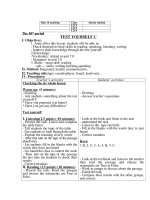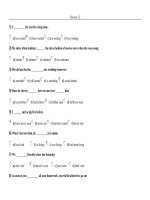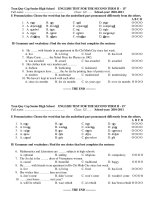review for the second ẽam
Bạn đang xem bản rút gọn của tài liệu. Xem và tải ngay bản đầy đủ của tài liệu tại đây (160.23 KB, 8 trang )
Period 64: Unit: 11 SOURCES OF ENERGY (READING ) Time : 45 minutes
I/ Objectives:
1/ Educational aim:- Help Ss to realise sources of energy that don’t cause pollute environment
2/Knowledge: Reading comprehension on some clearn sources of energy.
- Vocabulary: words and phrases about the topic and pronunciation
3/Skill:Read and guess the word mean. And answer some questions about the passage.
- Scan and find out information from the passage.
II/Method:Integrated, mainly communicative.
III/ Teaching aids: Textbook, cassette player, pictures.
IV/Procedure:
Teacher’ activities
1.Warm up ( 5’)
Write the sentences on the board and ask Ss to
complete.
1. we use ……… to cook
2. we use …… to run machines, cars, motobikes.
Correct answers in front of the class.
Lead into the new lesson
3. Presentation
Student’ activities
Group work.
1. oil, coal, wood, natural gas.
2. gas
2. Pre-reading:(5mns)
Ask Ss to look at the pictures on page 124 and to
discuss some questions:
Call some pairs to answer.
Feedback.
3. While-reading(30mns):
* New words:
Give some new words and the meaning in the
passage and read them and ask Ss to repeat.
- energy : năng lượng
- fossil : hóa thạch
- alternative (a) thay thế
- Geothermal heat : đòa nhiệt
- Sailboat : thuyền buồm
- Release (v) thải ra
- Infinite (a) vô tận
Play the tap and ask Ss tolisten and then silence
reading.
*Task 1:
Ask Ss to give the meaning of the words in the
box on page 125.
Tell Ss to do pairworks and fill each blank with a
suitable word.( can use a dictionary)
Call on some Ss to read the answer and give
correct answers.
* Task 2:
Ask Ss to scan the passage and write down the
advantage and disadvantage of each alternative
sources of energy.
Go around the class and help them if neccesary.
Ask Ss to check the result with their partners.
Call on some Ss to write thw answer on the
board and correct.
Pair work and give answer:
1.the left picture refers to wind energy. The upper
right picture refers to solar energy and the lower right
picture refers water power / energy
2. we need energy to live and work: to drive
machines, light and heat houses and produce st in
industry and agriculture.
New words:
Take note
Read the words.
Then, listen to the tap to read the passge.
Read it in silence and do the task follow.
Task 1:
1 released, 2 alternative, 3 energy
4 limited, exhausted.
Task 2:
Group work and individual work.
Task 3:
Pair works and give correct:
1. our main source of energy comes from fossil fuels.
2. ther are five sources of energy mentioned in the
* Task 3:
Ask Ss to work in pairs and discuss the
questions.
Call Ss to anwer in front of the class.
Give feedback.
4. Post – reading(5mns)
text. And I think solar energy is the most potential.
Ask Ss to complete the summary of the passage by
filling each blanc with a suitable word from the box.
Do around the class to help Ss if neccesary.
Call Ss to show the answers and feedback.
5. Home work
Ask Ss to do the exercise individually:
1. the potential of ……. Sources of energy is great.
a. the sun b. nuclear c. alternative
2. oil is…… kind of fossil fuel.
a. energy b. sources c. limited
Call Ss to answer and feedback.
Group works:
1. energy, 2 one, 3 fuels, 4 limited, 5 alternative, 6
sources, 7 unlimited, 8 environment.
Period 65 Unit 11 SOURCES OF ENERGY (B.SPEAKING) Time : 45
minutes
I/ OBJECTIVES:
1/ Educational aim: - Help Ss to realise sources of energy that don’t cause pollute environment.
2/Knowledge: - Ss can speak reasons of the use alternative sources of energy.
- Discuss advantage and disadvantage on the use alternative sources of energy.
3/Skill: - Speaking reasons of the use alternative sources of energy.
II/METHOD: -Communicative, integrated.
III/TEACHING material: - Textbook, extra-board.
IV/PROCEDURE:
Teacher’ activities
1. Warm up(5mns)
Give some questions
1. Which source of enery is the most popular in
our country?
2. Is it limited or unlimited? What should we do
to be sure that we can continue to use it in the
future?
Call on Ss to answer.
Lead into the new lesson.
2. Pre speaking(10mns)
- Present some new words
+ plentiful (adj) phong phú
+ unlimited (adj) nhiều , không giới hạn
+ renewable (adj) có thể phục hồi
+ convinient (adj) thuận tiện
3. While speaking(25mns)
Student’ activities
Group work and discuss the questions.
Task 1:
Tell Ss to read the sentences in the box and tick if
these facts are advantages or disadvantages.
Help Ss to pronunce correctly words in the task.
Ask Ss to work in pairs.
Check the answer in front of the class.
Task 2:
Explain the task demand.
Tell Ss to make short exchange about the
advantages and disadvantages of using alternative
source of energy. Using the suggestions from task 1
Ask Ss to read useful expressions, first And explain
if necessary.
Do model with a student.
Ask Ss to practise with partners.
Go around the class to help.
Feed back.
Task 3:
Ask Ss to work in pairs and to express your belief
on the increasing use of alternative sources in the
future, using the ideas from task 2.
Show Ss the model conversation.
Ask them practise.
4. After speaking(5mns)
Pair work and read sentences.
Task 2:
Pair work and practise conversation
A, more and more people worry about the shortage of
fossil fuels.
B, that’s true, and I think that wind power can be an
alternative source of energy.
A, why do you think so?
B, because our major source of energy is running out
while the wind is abundant and unlimited.
A, I know it is also clean and safe to the environment.
However it is not available when there is no wind
Task 3:
A: I think that more and more people will use the solar
energy.
B: why do you think so?
A: because it is available, unlimited and easy to use.
B: but it is expensive and we can only have it at specific
time of year.
A: I hope that the progress of science and technology
will help to overcome this problem
B: that’s right, we don’t worry about the shortage of
energy.
A: and our life will be more comfortabe with cheap
simple devices run on the solar energy.
Ask Ss practise the conversation infront of the class
and correct their pronunciation.
Practise it with partners.
5. Home work
Ask ss to write some advantage and disadvantages
of using one of sources of energy.
Tell Ss to prepare the next lesson.
Period 66 :Unit 11 : SOURCES OF ENERGY (C. LISTENING )Time : 45 minutes
I/ OBJECTIVES:
1/ Educational aim: - help Ss to realize sources of energy used in the future.
2/Knowledge: - Ss will listen the dialogue about natural fuels that is necessary for living.
3/Skill: - Listening for specific information. And answer questions
II/METHOD: -Communicate approach, integrated
III/TEACHING MATERIAL: - Textbook, cassette player,
IV/PROCEDURE:
Teacher’ activities Students’ activities
1. Warm up(5mns)
Write some words on the board, and ask Ss to answer
questions: the air, the sun the land, the ocean.
- what kind of energy can be taken from each of
these recourses?
Lead into the new lesson
Group work and discuss question:
The air wind power
The sun solar energy
The land geothermal heat
The ocean water power
2. Pre-listening(10mns)
Read the words: ecologist, recources, renewable, fossil
Read vocabulary and discuss answers:
- We guess it’s about the sources of energy. Some
fuels, unlimited, fertilized.
Ask Ss to repeat and guess context the passage.
- From the words, can you guess what the listening
text is about?
3. While you listen(25mns)
Task 1:
Explain the situation: you will hear a monologue about
the important of some vital natural resources.
Ask Ss to go through the questions first and then listen
to the tape and write down the answers.
Play cassette player several time untill Ss can
understand.
Check the answer in front of the class.
Task 2:
Ask Ss to work in pairs.
Ask Ss to read the paragragh and guess missing words.
Play the tape to Ss listen one time then check their
answer.
Then play tape again to Ss understand clearly.
4. Post listening(3mns)
ecologists can give some information about fossil
fuels. They may warn us that some sources are
limited and which one is renewable
Task 1;
Pair work and answer:
1. d 2. c 3.d 4.a 5.c
Task 2:
Pair work and check the answer:
1. unlimited 2. atmosphere 3. may
4. gases 5. amount
Ask Ss to group works and decide which group these
sources of energy belong to renewable or nonrenewable.
Feedback.
5. Home work (2mns)
Ask Ss to learn vocabulary and prepare the next lesson.
Ask Ss to choose the best answer:
Discuss and answer:
Period 67 Unit 11 SOURCES OF ENERGY (WRITING ) Time: 45minutes
I/ OBJECTIVES:
1/ Educational aim: - help Ss to realize alternative sources of energy used in the future.
2/Knowledge:- Describe the information of graph/ chart with cues.
3/Skill: - - description information of graph/ chart with cues.
II/METHOD: -Communicate approach, integrated
III/TEACHING Material: - Textbook, extra-boards
IV/PROCEDURE:
Teacher’ activities Students’ activities
1. Warm up(5mns)
Give questions
- what kind of energy is consumed the most in
Vietnam?
- Which one ranks next?
Lead into the new lesson.
Pairs work and answer;
- petroleum
- coal
- nuclear and hydroelectricity.
2. Pre – writing(10mns)
- Give ss some useful structures to write a paragraph
basing on a chart
+ to make up the largest of : chieám cao nhaát
+ to make up the smallest of ; chieám thaáp nhaát
3. While – writing(15mns)
Task 1:
Read the passage and individual work:
Answer:
1. 117million tons
2. coal,
3. smallest.
Task 2:
Read the task’s demand.
Ask Ss to work individually and fill in the gaps in the
passage with the exact information from the chart given.
Call on some Ss to compare the answer with partners
then feedback.
Task 2:
Ask Ss to work individually and to continue their
description of the trends in energy consumption in the
year 2005 in Highland.
Go around the class to help Ss as necessary
Call on some Ss to write their description on the board
Give correct answers.
Task 3:
Ask Ss to pair work, and describe the chart, using the
information from task 1 and 2.
Go around the class to help Ss.
Call on some Ss to write the answer on the board
Give correct answer.
4. Pre – writing(5mns)
Work individually answer write paragraph:
In the year 2005, as can be seen, the total energy
consumption was 170 million tons. Nuclear and
hydroelectricity made up the largest amuont of this
figure. As the chart shows, the consumption of coal
and petroleum nearly equal. Coal made up the
amount of 45 million tons and petroleum reached
the amount of 50 million tons.
Task 3:
Pair work and answer;
According to chart, there was a sharp increase in
the consumption of nuclear and hydroelectriscity in
the year 2000 and in the year 2005. Meanwhile the
consumption of coal rose slightly and on the
constrary, there was a slight fall in the consumption
of petroleum.
Review the structures to write the chart.
5. Home work (5mns)
Ask Ss to rewrite the paragraph in their note book. And
prepare the next lesson.
Take note
Period 68 Unit 11: SOURCES OF ENERGY ( LANGUAGE FOCUS ) Time 45 minutes
I/ OBJECTIVES:
1/ Educational aim: Help ss to enrich their knowledge about English
2/Knowledge:students will pronounce the sounds / /, / /, and / / correctly
- know how to use of Relative clauses replaced by participles and to infinitives -
3/Skill: Pronunciation and practicing grammar
II/METHOD: - Integrated, Communicative
III/TEACHING MATERIAL: - Textbook, extra-board
IV/PROCEDURES:
Teacher’ activities Students’ activities
1. Warm up(5mns)
Give two situations and ask Ss to rewrite sentences using
relative pronoun.
1. I want the car. It is made in Japan
2. the singer is a disable girl. She is singing on TV
Show the way of the use participles:
1. I want the car made in Japan
2. The singer singing on TV is a disable girl
Introduce the new lesson.
Work in groups in 2 minutes
- Answer
1. I want the car which is made in japan.
2. The singer who is singing on TV is a
disable girl.
2. Pronunciation:(10mns) / /, / spl /, and /spr /
Write some words on the black board and ask Ss to read and to
show the consonant sounds: shrill – split – spring - spray.
-Correct their pronunciation.
-Introduce pronunciation we are learning today.
Take notes, Read the sounds as a whole class
- Repeat the sounds
- Help ss to pronounce and then distinguish the sounds
- Read the words three columns and ask Ss to repeat.
- Call on some ss to practise
- Ask ss to work in pairs to act out the dialogue.
- Select somr pairs to practise
3. Grammar: Relative clauses replaced by participles and to
infinitives( revision)(15mns)
a/ Relative clause replaced by past or present particibles.
Explain example:
1. I want to the car which is made in Japan.
→ I want to the car made in Japan.
2. the singer who is singing on TV is a disable girl
→ the singer singing on TV is a disable girl
Note:
- Relative clauses/ using paticiples were replaced when relative
pronoun is subject.
- Relative clauses/ using paticiples were replaced when the time
of two clauses is exact clearly.
Ex:Do you know the man who has stolen your motobike.(khong
thay the menh de tinh tu.)
4. Practice (15mns)
Exercise 1
Ask Ss to work in pairs and to rewrite the sentences, using a
present participail phrase.
Move around and help
Call on some ss to answer
Feeback.
Exercise 2
- ask Ss to rewrite the sentences using a past participial phrase.
- Move around and help
- Call some ss to answer
- Feedback
b/ Relative clause replaced by to infinitive .
- Antecedent with ordinal numbers or with the word onl (khi tiền
ngữ với số thứ tự or only)
Ex: he was the first man who reached the top of this mountain.
→ he was the first man to reach the top of this mountain.
- khi mệnh đề tính từ diễn tả sự cần thiết, nhiệm vụ phải làm.
Ex: he has some home work that he much do.
→ he has some home work to do.
Ex: they need a large yard in which they can dry rice.
→ they need a large yard to dry rice.
Exercise 3:
Ask Ss to to in group and do the exercise
Go around the class to help them if necessary.
Call on Ss to write the asnwer on the board.
Give correct answer.
5. Homework
- tell Ss to redo all the exercises and prepare for the next
lesson
- Work in pairs
- Practise
Take notes
Exercise 1:
Pair work and answer:
1. the boy playing the piano is Ben
2. do you know the woman coming toward
us?
3. the people waiting for the bus in the rain
are getting wet
4. the scientists researching … are making
some progress
5. the fence surrounding our house is made
of wood
6. we have an apartment overlooking the
park
Exercise 2 :
Pair work and write your answer on the board:
1. the ideas presented in that book are
interesting.
2. I come from a city located in the
southern part of the country.
3. they live in a house built in 1890.
4. the photographs published in the
newspaper were extraordinary.
5. the experiment conducted at the ….
6. they work in a hospital sponsored by the
government
Exercise 3:
Group work and asnwer:
1. john was the last man to reach the top
2. the last person to leaves the room must …
3. the last person to see is
4. this is the second person to killed in that
way
5. the first person to catch the ball will be
the winner.




